Land Use Optimization Embedding in Ecological Suitability in the Embryonic Urban Agglomeration
Abstract
1. Introduction
2. Materials and Methods
2.1. Study Area
2.2. Data Sources
2.3. Methods
2.3.1. Evaluating the Land Ecological Suitability
- (1)
- Multi-factor weighted overlay analysis
- (2)
- The MCR model
- (3)
- Land ecological suitability zoning
2.3.2. The MCR-MOP-Dyna-CLUE Model Framework
- (1)
- Establishing probability maps of land use type distribution
- (2)
- Setting simulation scenarios
- (3)
- The MOP model
3. Results
3.1. Temporal and Spatial Changes of Land Use during 1995–2020
3.2. The Land Ecological Suitability Zoning
3.2.1. Minimum Cumulative Resistance Surfaces of Ecological Sources and Construction Sources
3.2.2. The Land Ecological Suitability Zones
3.3. Land Use Simulation Results
3.3.1. Logistic Regression of Driving Factors
3.3.2. Results of the Land Use Simulation
4. Discussion
4.1. The Compositive MCR-MOP-Dyna-CLUE Model Framework
4.2. Land Use Optimization Project
4.3. Policy Implications
4.4. Limitations and Future Research
5. Conclusions
Supplementary Materials
Author Contributions
Funding
Data Availability Statement
Conflicts of Interest
References
- Fang, C.L.; Yu, D.L. Urban agglomeration: An evolving concept of an emerging phenomenon. Landsc. Urban Plan. 2017, 162, 126–136. [Google Scholar] [CrossRef]
- Fang, C.L. The basic law of the formation and expansion in urban agglomerations. J. Geogr. Sci. 2019, 29, 1699–1712. [Google Scholar] [CrossRef]
- Li, J.Z.; Ouyang, X.; Zhu, X. Land space simulation of urban agglomerations from the perspective of the symbiosis of urban development and ecological protection: A case study of Changsha-Zhuzhou-Xiangtan urban agglomeration. Ecol. Indic. 2021, 126, 107669. [Google Scholar] [CrossRef]
- Ouyang, X.; Xu, J.; Li, J.Y.; Wei, X.; Li, Y.H. Land space optimization of urban-agriculture-ecological functions in the Changsha-Zhuzhou-Xiangtan Urban Agglomeration, China. Land Use Policy 2022, 117, 106112. [Google Scholar] [CrossRef]
- Simkin, R.D.; Seto, K.C.; McDonald, R.I.; Jetz, W. Biodiversity impacts and conservation implications of urban land expansion projected to 2050. Proc. Natl. Acad. Sci. USA 2022, 119, e2117297119. [Google Scholar] [CrossRef] [PubMed]
- Fang, C.L.; Zhang, G.Y.; Xue, D.S. High-quality development of urban agglomerations in China and construction of science and technology collaborative innovation community. Acta Geogr. Sin. 2021, 76, 2898–2908. [Google Scholar] [CrossRef]
- Pan, T.T.; Yan, F.Q.; Su, F.Z.; Lyne, V.; Zhou, C.D. Land Use Optimization for Coastal Urban Agglomerations Based on Economic and Ecological Gravitational Linkages and Accessibility. Land 2022, 11, 1003. [Google Scholar] [CrossRef]
- Marull, J.; Pino, J.; Tello, E.; Cordobilla, M.J. Social metabolism, landscape change and land-use planning in the Barcelona Metropolitan Region. Land Use Policy 2010, 27, 497–510. [Google Scholar] [CrossRef]
- Hasegawa, T.; Fujimori, S.; Ito, A.; Takahashi, K.; Masui, T. Global land-use allocation model linked to an integrated assessment model. Sci. Total Environ. 2017, 580, 787–796. [Google Scholar] [CrossRef] [PubMed]
- Verburg, P.H.; Tabeau, A.; Hatna, E. Assessing spatial uncertainties of land allocation using a scenario approach and sensitivity analysis: A study for land use in Europe. J. Environ. Manag. 2013, 127, S132–S144. [Google Scholar] [CrossRef]
- Chakir, R.; Le Gallo, J. Predicting land use allocation in France: A spatial panel data analysis. Ecol. Econ. 2013, 92, 114–125. [Google Scholar] [CrossRef]
- Wu, X.T.; Wang, S.; Fu, B.J.; Liu, Y.; Zhu, Y. Land use optimization based on ecosystem service assessment: A case study in the Yanhe watershed. Land Use Policy 2018, 72, 303–312. [Google Scholar] [CrossRef]
- Zheng, W.W.; Ke, X.L.; Xiao, B.Y.; Zhou, T. Optimising land use allocation to balance ecosystem services and economic bene-fits—A case study in Wuhan, China. J. Environ. Manag. 2019, 248, 109306. [Google Scholar] [CrossRef]
- Sun, X.; Crittenden, J.C.; Li, F.; Lu, Z.M.; Dou, X.L. Urban expansion simulation and the spatio-temporal changes of ecosystem services, a case study in Atlanta Metropolitan area, USA. Sci. Total Environ. 2018, 622, 974–987. [Google Scholar] [CrossRef]
- Ma, B.Y.; Huang, J.; Li, S.C. Optimal allocation of land use types in the Beijing-Tianjin-Hebei urban agglomeration based on ecological and economic benefits trade-offs. Prog. Geogr. 2019, 38, 26–37. [Google Scholar] [CrossRef]
- Hu, M.M.; Wang, Y.F.; Xia, B.C.; Jiao, M.Y.; Huang, G.H. How to balance ecosystem services and economic benefits?–A case study in the Pearl River Delta, China. J. Environ. Manag. 2020, 271, 110917. [Google Scholar] [CrossRef] [PubMed]
- Zhang, X.; Gu, R. Spatio-temporal pattern and multi-scenario simulation of land use conflict: A case study of the Yangtze River Delta urban agglomeration. Geogr. Res. 2022, 41, 1311–1326. [Google Scholar] [CrossRef]
- Yan, Y.L.; Yu, T.; Chen, H. Development Stage, Spatial Expansion and Dynamic Mechanism of National Urban Agglomeration. Areal Res. Dev. 2021, 40, 51–57. [Google Scholar] [CrossRef]
- Jia, Z.; Zhao, J.; Yang, Y.; Chen, X. Spatial pattern and spatial convergence of environmental regulation efficiency of Lanzhou-Xining urban agglomeration in the Yellow River Basin. J. Sci. Geogr. Sin. 2022, 42, 568–578. [Google Scholar] [CrossRef]
- Yang, Y.; Zhang, X.; Mu, Y.; Zhang, W. The basic logic and core strategies of ecological protection and high-quality development in the upper reaches of the Yellow River. Econ. Geogr. 2020, 40, 9–20. [Google Scholar] [CrossRef]
- Zheng, X.Q.; Zhao, L.; Xiang, W.N.; Li, N.; Lv, L.N.; Yang, X. A coupled model for simulating spatio-temporal dynamics of land-use change: A case study in Changqing, Jinan, China. Landsc. Urban Plan. 2012, 106, 51–61. [Google Scholar] [CrossRef]
- Li, X.X.; Ma, W.Y.; Xu, L. Land use structure optimization research based on the markov chain in the west of Jilin province. Res. Soil Water Conserv. 2013, 20, 229–232+237+311. [Google Scholar]
- Guo, X.Y.; Liu, X.L.; Wang, L.G. Land use optimization in order to improve ecosystem service: A case of Lanzhou city. Acta Ecol. Sin. 2016, 36, 7992–8001. [Google Scholar] [CrossRef]
- Tayyebi, A.; Pijanowski, B.C. Modeling multiple land use changes using ANN, CART and MARS: Comparing tradeoffs in goodness of fit and explanatory power of data mining tools. Int. J. Appl. Earth Obs. Geoinf. 2014, 28, 102–116. [Google Scholar] [CrossRef]
- Liao, G.T.; He, P.; Gao, X.S.; Lin, Z.Y.; Huang, C.Y.; Zhou, W.; Deng, O.P.; Xu, C.H.; Deng, L.J. Land use optimization of rural production-living-ecological space at different scales based on the BP-ANN and CLUE-S models. Ecol. Indic. 2022, 137, 108710. [Google Scholar] [CrossRef]
- Ning, S.; Zhang, Z.Y.; Zhou, H.W.; Li, L.; Zhao, G.N. Optimization of land use structure based on ecological service value in Manas River Basin. Acta Ecol. Sin. 2019, 39, 5208–5217. [Google Scholar] [CrossRef]
- Li, W.; Chen, Z.J.; Li, M.C.; Zhang, H.; Li, M.Y.; Qiu, X.Q.; Zhou, C. Carbon emission and economic development trade-offs for optimizing land-use allocation in the Yangtze River Delta, China. Ecol. Indic. 2023, 147, 109950. [Google Scholar] [CrossRef]
- Rahman, M.M.; Szabo, G. Multi-objective urban land use optimization using spatial data: A systematic review. Sustain. Cities Soc. 2021, 74, 103214. [Google Scholar] [CrossRef]
- Wang, Y.; Li, X.M.; Zhang, Q.; Li, J.F.; Zhou, X.W. Projections of future land use changes: Multiple scenarios -based impacts analysis on ecosystem services for Wuhan city, China. Ecol. Indic. 2018, 94, 430–445. [Google Scholar] [CrossRef]
- Crooks, A.T. Constructing and implementing an agent-based model of residential segregation through vector GIS. Int. J. Geogr. Inf. Sci. 2010, 24, 661–675. [Google Scholar] [CrossRef]
- Ma, S.F.; He, J.H.; Liu, F.; Yu, Y. Land-use spatial optimization based on PSO algorithm. Geo-Spat. Inf. Sci. 2011, 14, 54–61. [Google Scholar] [CrossRef]
- Mohamed, A.; Worku, H. Simulating urban land use and cover dynamics using cellular automata and Markov chain approach in Addis Ababa and the surrounding. Urban Clim. 2020, 31, 100545. [Google Scholar] [CrossRef]
- Wang, Y.Y.; Chao, B.X.; Dong, P.; Zhang, D.A.; Yu, W.W.; Hu, W.J.; Ma, Z.Y.; Chen, G.C.; Liu, Z.H.; Chen, B. Simulating spatial change of mangrove habitat under the impact of coastal land use: Coupling MaxEnt and Dyna-CLUE models. Sci. Total Environ. 2021, 788, 147914. [Google Scholar] [CrossRef] [PubMed]
- Lin, W.B.; Sun, Y.M.; Nijhuis, S.; Wang, Z.L. Scenario-based flood risk assessment for urbanizing deltas using future land-use simulation (FLUS): Guangzhou Metropolitan Area as a case study. Sci. Total Environ. 2020, 739, 139899. [Google Scholar] [CrossRef] [PubMed]
- Liang, X.; Guan, Q.F.; Clarke, K.C.; Liu, S.S.; Wang, B.Y.; Yao, Y. Understanding the drivers of sustainable land expansion using a patch-generating land use simulation (PLUS) model: A case study in Wuhan, China. Comput. Environ. Urban Syst. 2021, 85, 101569. [Google Scholar] [CrossRef]
- Lin, J.Y.; Li, X.; Wen, Y.Y.; He, P.T. Modeling urban land-use changes using a landscape-driven patch-based cellular automaton (LP-CA). Cities 2023, 132, 103906. [Google Scholar] [CrossRef]
- Geng, X.; Hu, S.; Xiao, Y.; Wang, X.M. Land use pattern optimization and evaluation based on ESVof agro-pastoral ecotone in Northeast China. J. Nat. Resour. 2022, 37, 1799–1814. [Google Scholar] [CrossRef]
- Verburg, P.H.; Overmars, K.P. Combining top-down and bottom-up dynamics in land use modeling: Exploring the future of abandoned farmlands in Europe with the Dyna-CLUE model. Landsc. Ecol. 2009, 24, 1167–1181. [Google Scholar] [CrossRef]
- Verburg, P.H.; Soepboer, W.; Veldkamp, A.; Limpiada, R.; Espaldon, V.; Mastura, S.S. Modeling the spatial dynamics of regional land use: The CLUE-S model. Environ. Manag. 2002, 30, 391–405. [Google Scholar] [CrossRef]
- McHarg, I.; Mumford, L. Design with Nature; American Museum of Natural History: New York, NY, USA, 1969. [Google Scholar]
- Franco, L.; Magalhães, M.R. Assessing the ecological suitability of land-use change. Lessons learned from a rural marginal area in southeast Portugal. Land Use Policy 2022, 122, 106381. [Google Scholar] [CrossRef]
- Zheng, Q.; Yang, X.; Wang, K.; Huang, L.Y.; Shahtahmassebi, A.R.; Gan, M.Y.; Weston, M.V. Delimiting Urban Growth Boundary through Combining Land Suitability Evaluation and Cellular Automata. Sustainability 2017, 9, 2213. [Google Scholar] [CrossRef]
- Chen, Y.P.; Zheng, B.H.; Liu, R.J. The Evolution of Ecological Space in an Urban Agglomeration Based on a Suitability Evaluation and Cellular Automata Simulation. Sustainability 2022, 14, 7455. [Google Scholar] [CrossRef]
- Li, Q.G.; Wang, L.C.; Gul, H.N.; Li, D. Simulation and optimization of land use pattern to embed ecological suitability in an oasis region: A case study of Ganzhou district, Gansu province, China. J. Environ. Manag. 2021, 287, 112321. [Google Scholar] [CrossRef]
- Liu, Y.S.; Wang, J.Y.; Guo, L.Y. GIS-based assessment of land suitability for optimal allocation in the Qinling Mountains, China. Pedosphere 2006, 16, 579–586. [Google Scholar] [CrossRef]
- Dai, L.; Liu, Y.B.; Luo, X.Y. Integrating the MCR and DOI models to construct an ecological security network for the urban agglomeration around Poyang Lake, China. Sci. Total Environ. 2021, 754, 141868. [Google Scholar] [CrossRef] [PubMed]
- Ning, J.; Liu, J.Y.; Kuang, W.H.; Xu, X.L.; Zhang, S.W.; Yan, C.Z.; Li, R.D.; Wu, S.X.; Hu, Y.F.; Du, G.M.; et al. Spatiotemporal patterns and characteristics of land-use change in China during 2010–2015. J. Geogr. Sci. 2018, 28, 547–562. [Google Scholar] [CrossRef]
- Xu, X.; Liu, J.; Zhang, S.; Li, R.; Yan, C.; Wu, S. China’s Multiperiod Land Use Land Cover Remote Sensing Monitoring Dataset; (CNLUCC), Chinese Academy of Sciences Resource and Environmental Science Data Center Data Registration and Publishing System: Beijing, China, 2018. [Google Scholar] [CrossRef]
- Li, L.; Huang, X.J.; Wu, D.F.; Wang, Z.L.; Yang, H. Optimization of ecological security patterns considering both natural and social disturbances in China’s largest urban agglomeration. Ecol. Eng. 2022, 180, 106647. [Google Scholar] [CrossRef]
- Wei, L.; Zhou, L.; Sun, D.Q.; Yuan, B.; Hu, F.N. Evaluating the impact of urban expansion on the habitat quality and constructing ecological security patterns: A case study of Jiziwan in the Yellow River Basin, China. Ecol. Indic. 2022, 145, 109544. [Google Scholar] [CrossRef]
- Zhou, D.; Xu, J.C.; Lin, Z.L. Conflict or coordination? Assessing land use multi-functionalization using production-living-ecology analysis. Sci. Total Environ. 2017, 577, 136–147. [Google Scholar] [CrossRef]
- Yan, Y.T.; Zhou, R.; Ye, X.Y.; Zhang, H.; Wang, X.J. Suitability evaluation of urban construction land based on an approach of vertical-horizontal processes. ISPRS Int. J. Geo-Inf. 2018, 7, 198. [Google Scholar] [CrossRef]
- Akin, A.; Erdogan, N.; Berberoglu, S.; Cilek, A.; Erdogan, A.; Donmez, C.; Satir, O. Evaluating the efficiency of future crop pattern modelling using the CLUE-S approach in an agricultural plain. Ecol. Inform. 2022, 71, 101806. [Google Scholar] [CrossRef]
- Peng, K.F.; Jiang, W.G.; Deng, Y.; Liu, Y.H.; Wu, Z.F.; Chen, Z. Simulating wetland changes under different scenarios based on integrating the random forest and CLUE-S models: A case study of Wuhan Urban Agglomeration. Ecol. Indic. 2020, 117, 106671. [Google Scholar] [CrossRef]
- Johnston, R.; Jones, K.; Manley, D. Confounding and collinearity in regression analysis: A cautionary tale and an alternative procedure, illustrated by studies of British voting behaviour. Qual. Quant. 2018, 52, 1957–1976. [Google Scholar] [CrossRef]
- Chen, W.; Li, J.F.; Zhu, L. Spatial heterogeneity and sensitivity analysis of ecosystem services value in the Middle Yangtze River region. J. Nat. Resour 2019, 34, 325–337. [Google Scholar] [CrossRef]
- Xie, G.D.; Zhang, C.X.; Zhen, L.; Zhang, L.M. Dynamic changes in the value of China’s ecosystem services. Ecosyst. Serv. 2017, 26, 146–154. [Google Scholar] [CrossRef]
- Zhou, Y.; Chang, J.; Feng, S.S. Effects of urban growth boundaries on urban spatial structural and ecological functional optimi-zation in the Jining Metropolitan Area, China. Land Use Policy 2022, 117, 106113. [Google Scholar] [CrossRef]
- Liu, Y.F.; Ming, D.P.; Yang, J.Y. Optimization of land use structure based on ecological GREEN equivalent. Geo-Spat. Inf. Sci. 2002, 5, 60–67. [Google Scholar] [CrossRef]
- Fu, J.Y.; Bu, Z.Q.; Jiang, D.; Lin, G.; Li, X. Sustainable land use diagnosis based on the perspective of production–living–ecolog-ical spaces in China. Land Use Policy 2022, 122, 106386. [Google Scholar] [CrossRef]
- Song, X.P.; Hansen, M.C.; Stehman, S.V.; Potapov, P.V.; Tyukavina, A.; Vermote, E.F.; Townshend, J.R. Global land change from 1982 to 2016. Nature 2018, 560, 639–643. [Google Scholar] [CrossRef]
- Yang, X.D. Landscape Ecological Risk Evaluation of Lanxi City Cluster and its Early Warning Research; Northwest Normal University: Lanzhou, China, 2021. [Google Scholar]
- Wang, Q.R.; Liu, R.M.; Men, C.; Guo, L.J. Application of genetic algorithm to land use optimization for non-point source pollution control based on CLUE-S and SWAT. J. Hydrol. 2018, 560, 86–96. [Google Scholar] [CrossRef]
- Liu, P.J.; Hu, Y.C.; Jia, W.T. Land use optimization research based on FLUS model and ecosystem services-setting Jinan City as an example. Urban Clim. 2021, 40, 100984. [Google Scholar] [CrossRef]
- Li, Q.G.; Wang, L.C.; Yan, C.X.; Liu, H.Y. Simulation of urban spatial expansion in oasis towns based on habitat quality: A case study of the middle reaches of Heihe River. Acta Ecol. Sin 2020, 40, 2920–2931. [Google Scholar] [CrossRef]
- Gu, M.L.; Ye, C.S.; Li, X.; Hu, H.P. Land-Use optimization based on ecosystem service value: A case study of urban agglomeration around Poyang lake, China. Sustainability 2022, 14, 7131. [Google Scholar] [CrossRef]
- Yang, X.D.; Chen, X.P.; Qiao, F.W.; Che, L.; Pu, L.L. Layout optimization and multi-scenarios for land use: An empirical study of production-living-ecological space in the Lanzhou-Xining City Cluster, China. Ecol. Indic. 2022, 145, 109577. [Google Scholar] [CrossRef]
- Fang, C.L. Spatial organization pattern and high-quality development of urban agglomeration in the Yellow River Basin. Econ. Geogr 2020, 40, 1–8. [Google Scholar] [CrossRef]
- Chen, X.D.; Shi, P.J.; Wang, C.; Yue, X.X.; Liu, X.X.; Zhang, W.M. Responses of landscape ecological pattern to the expansion of urban construction land in river valley city under different scenarios: A case study of Lanzhou. Chin. J. Ecol. 2018, 37, 3381–3389. [Google Scholar] [CrossRef]
- Yu, Q.; Yue, D.P.; Wang, J.P.; Zhang, Q.B.; Li, Y.T.; Yu, Y.; Chen, J.X.; Li, N. The optimization of urban ecological infrastructure network based on the changes of county landscape patterns: A typical case study of ecological fragile zone located at Deng Kou (Inner Mongolia). J. Clean. Prod. 2017, 163, S54–S67. [Google Scholar] [CrossRef]
- Tong, H.L.; Shi, P.J. Using ecosystem service supply and ecosystem sensitivity to identify landscape ecology security patterns in the Lanzhou-Xining urban agglomeration, China. J. Mt. Sci. 2020, 17, 2758–2773. [Google Scholar] [CrossRef]
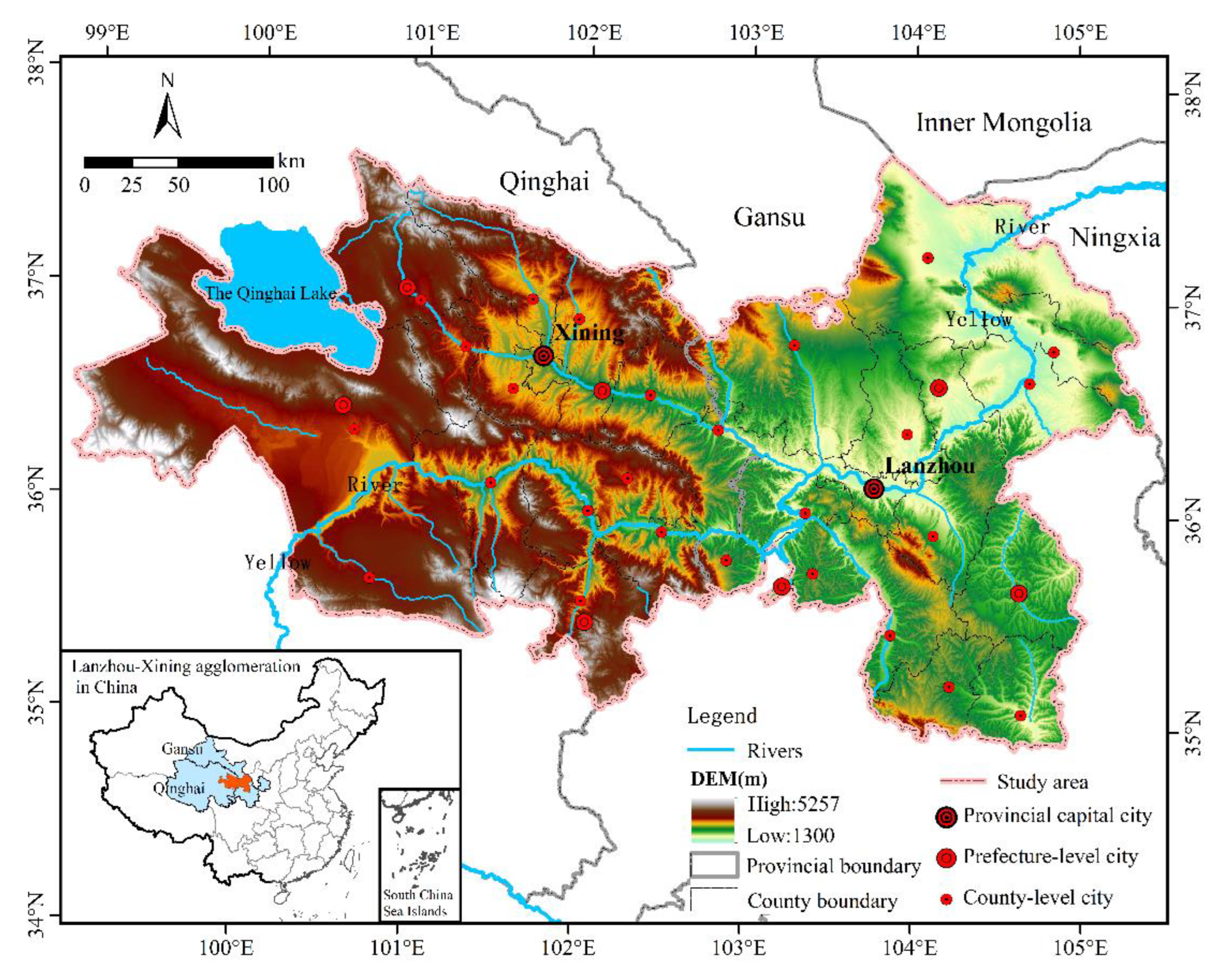
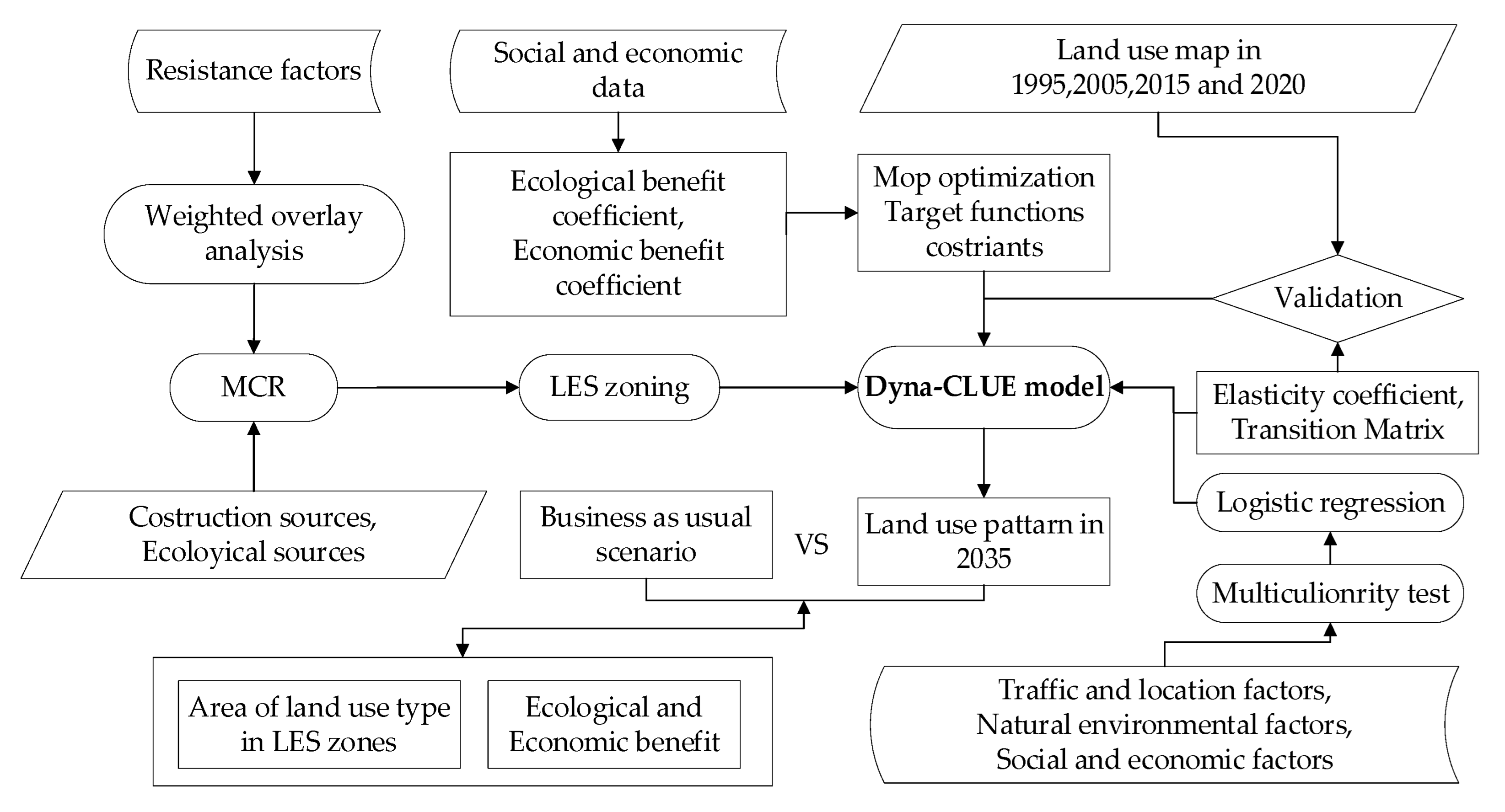
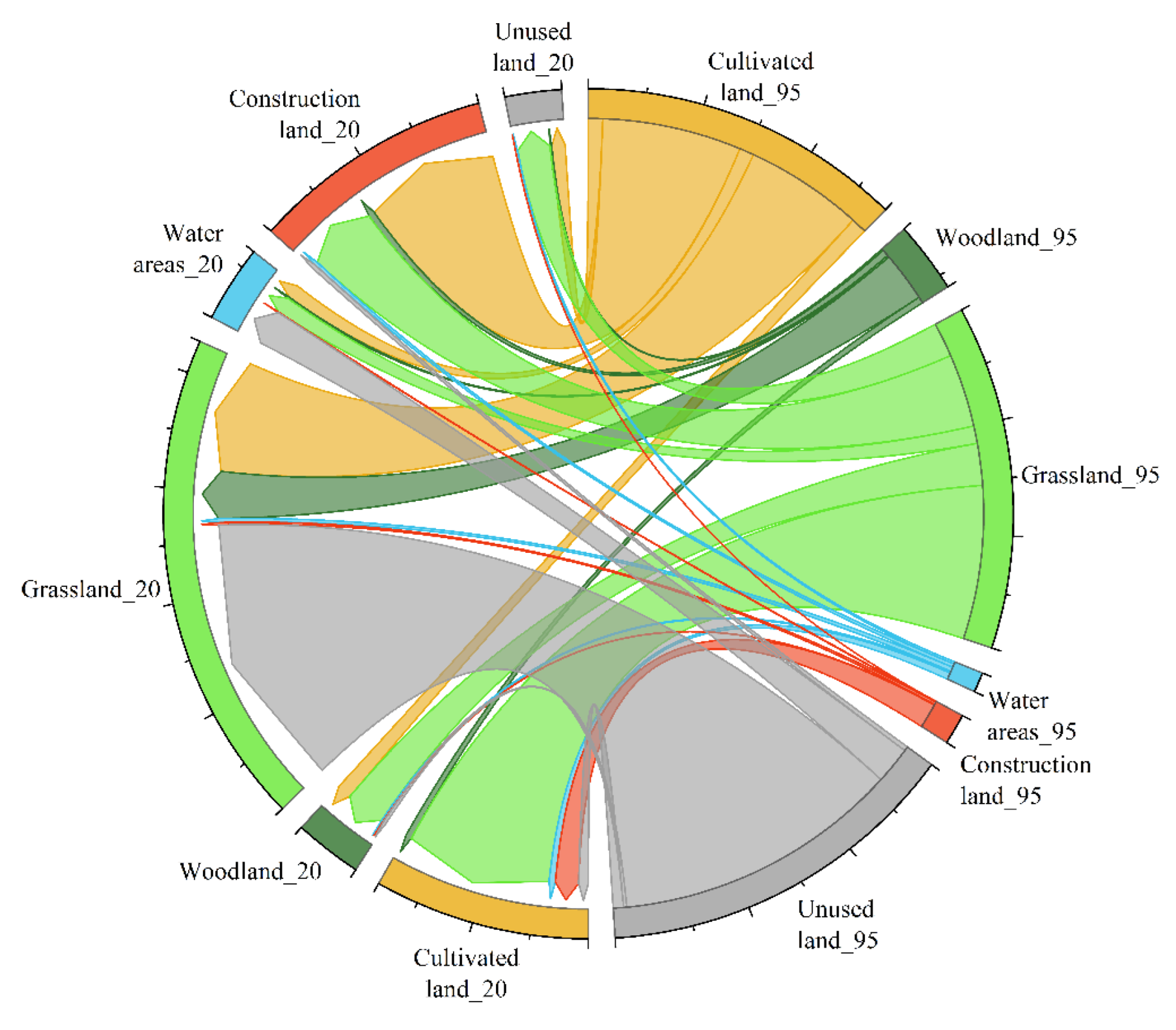
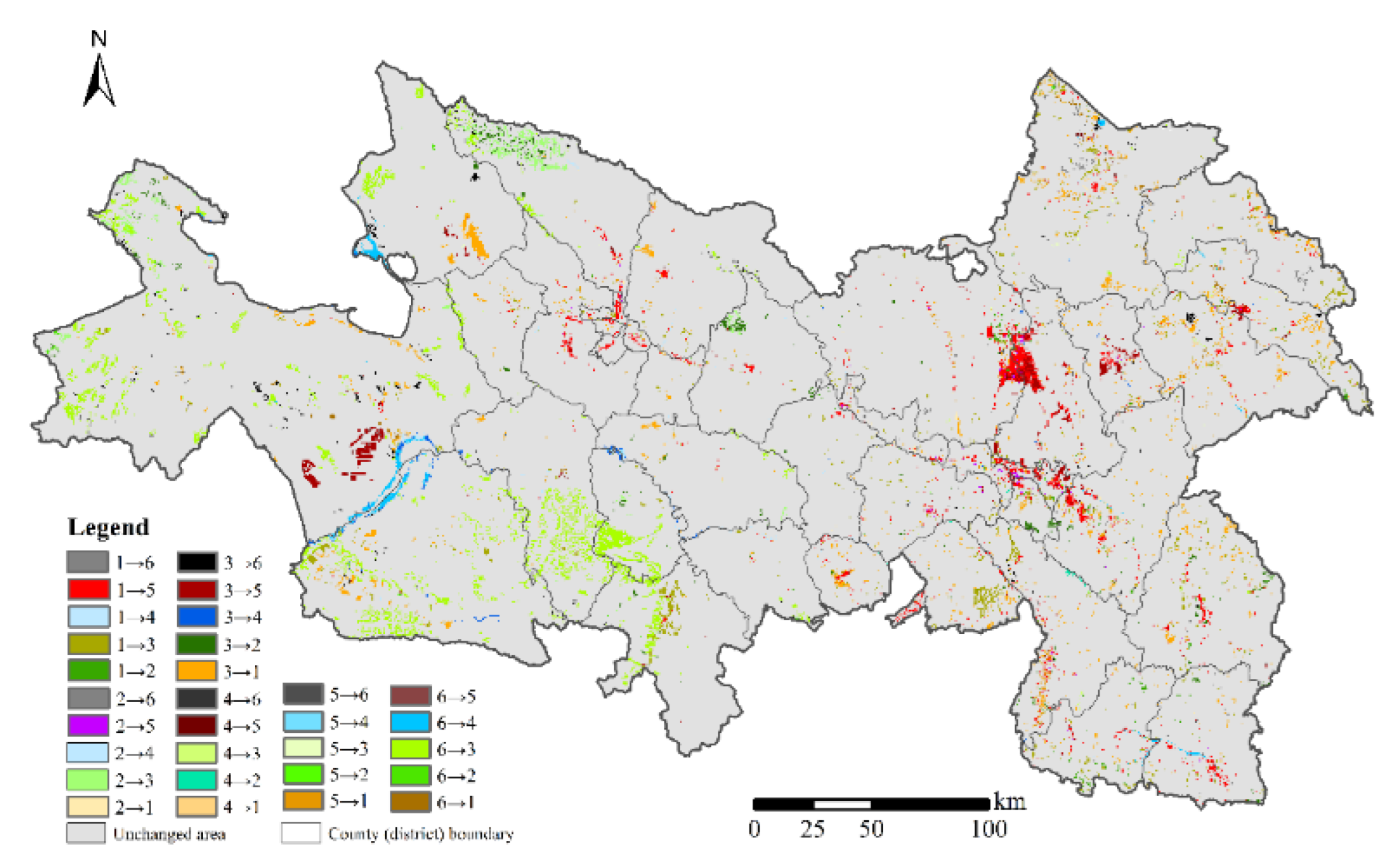
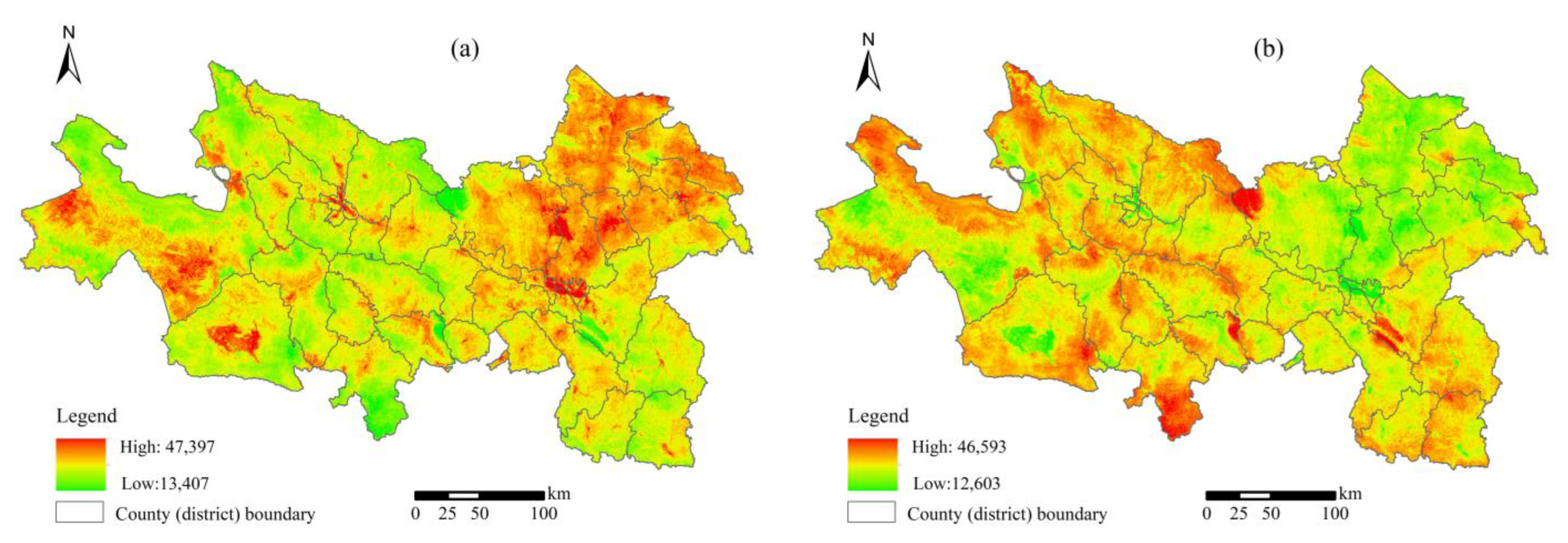
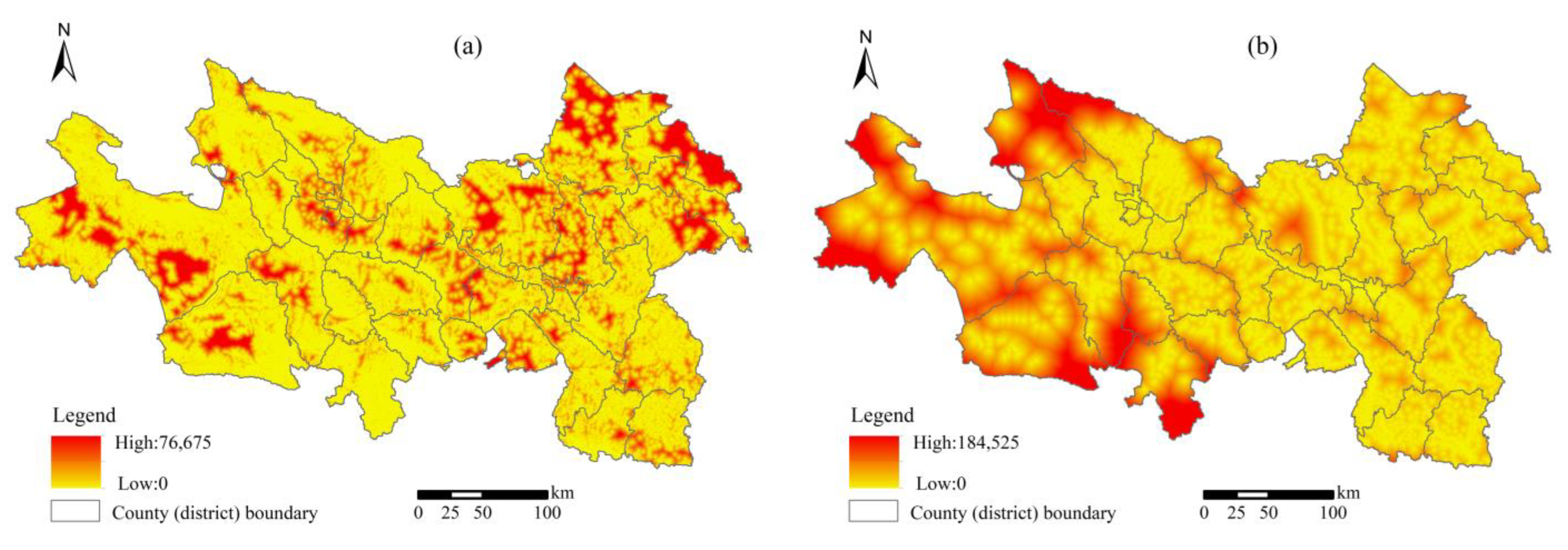
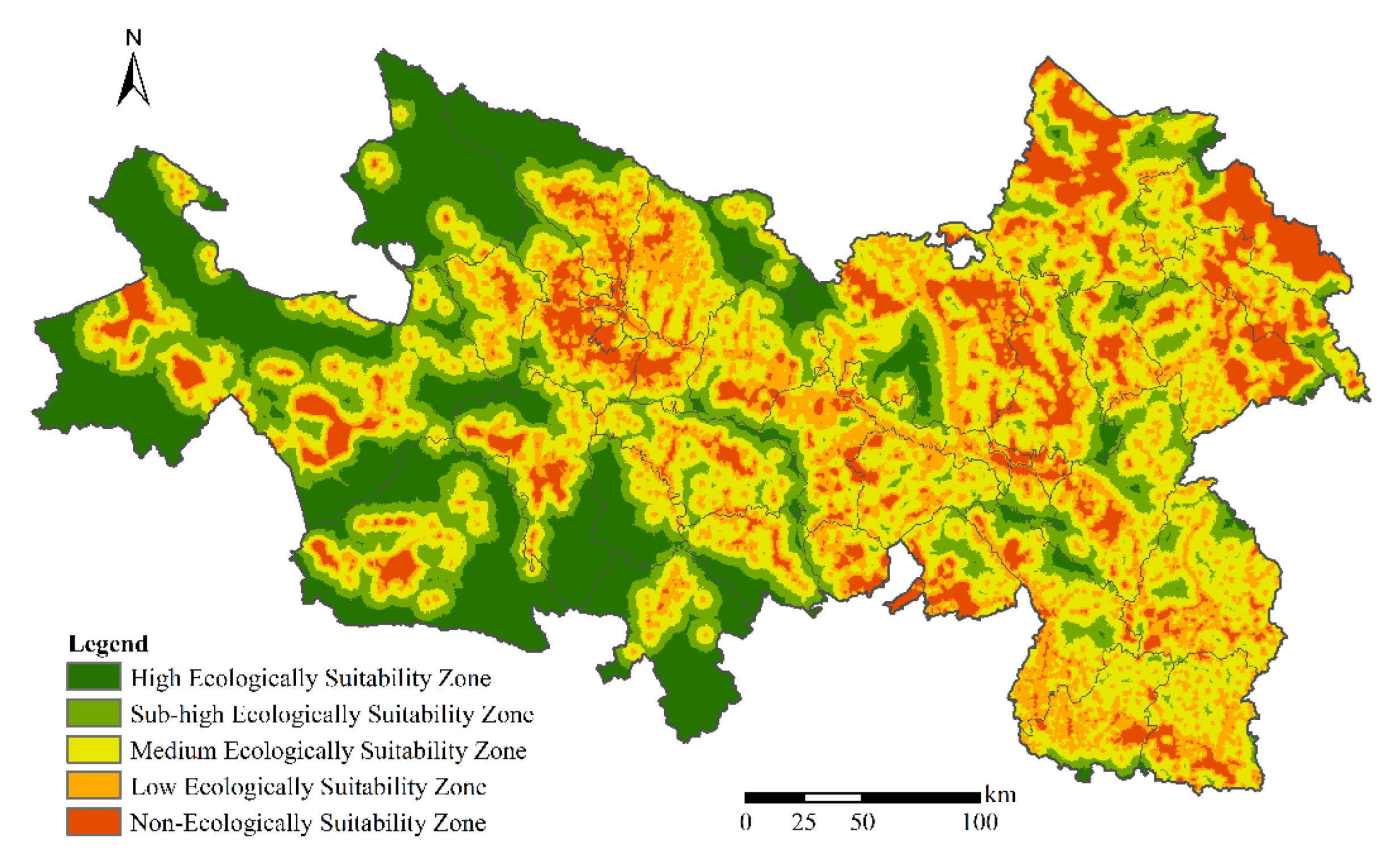
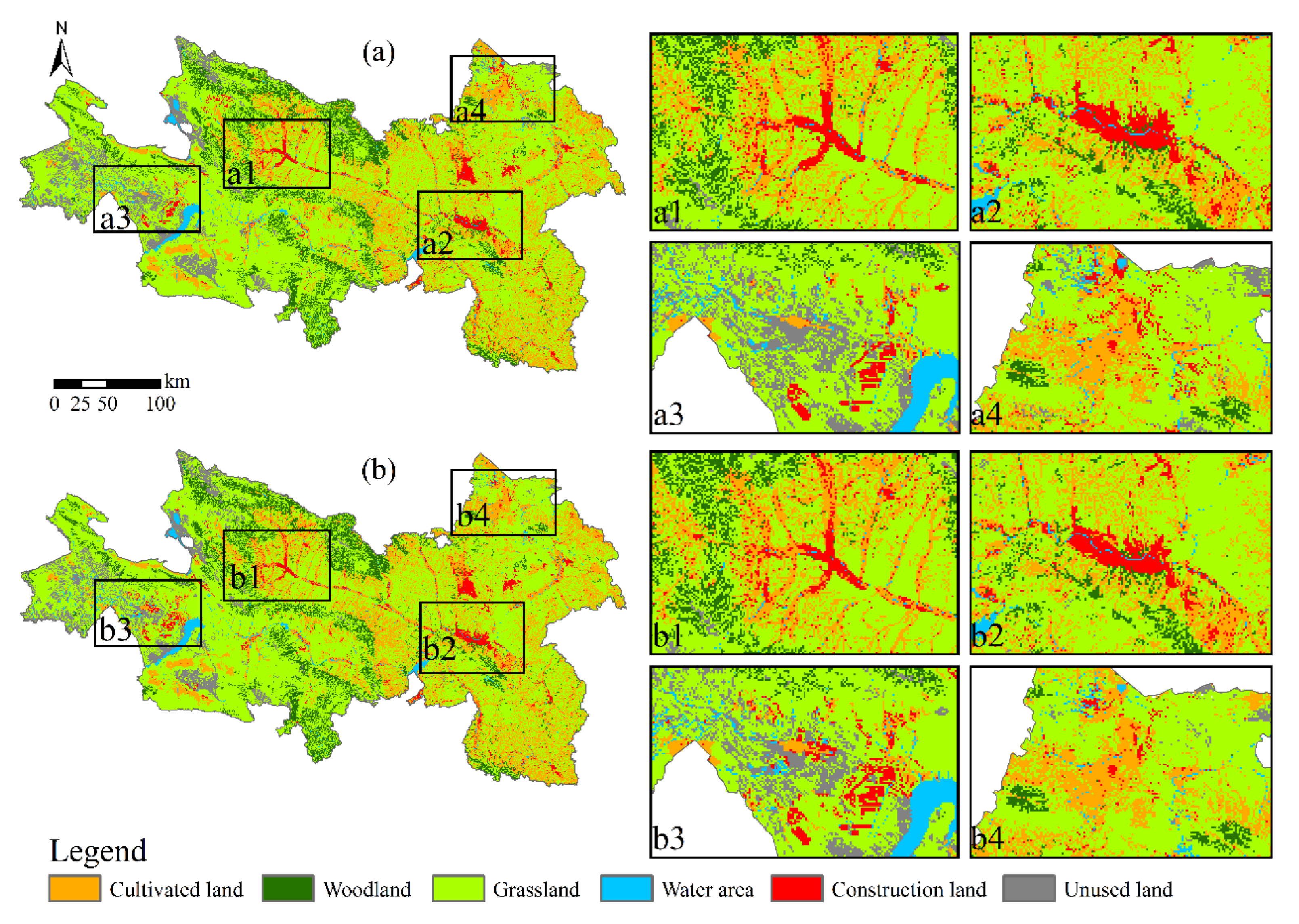
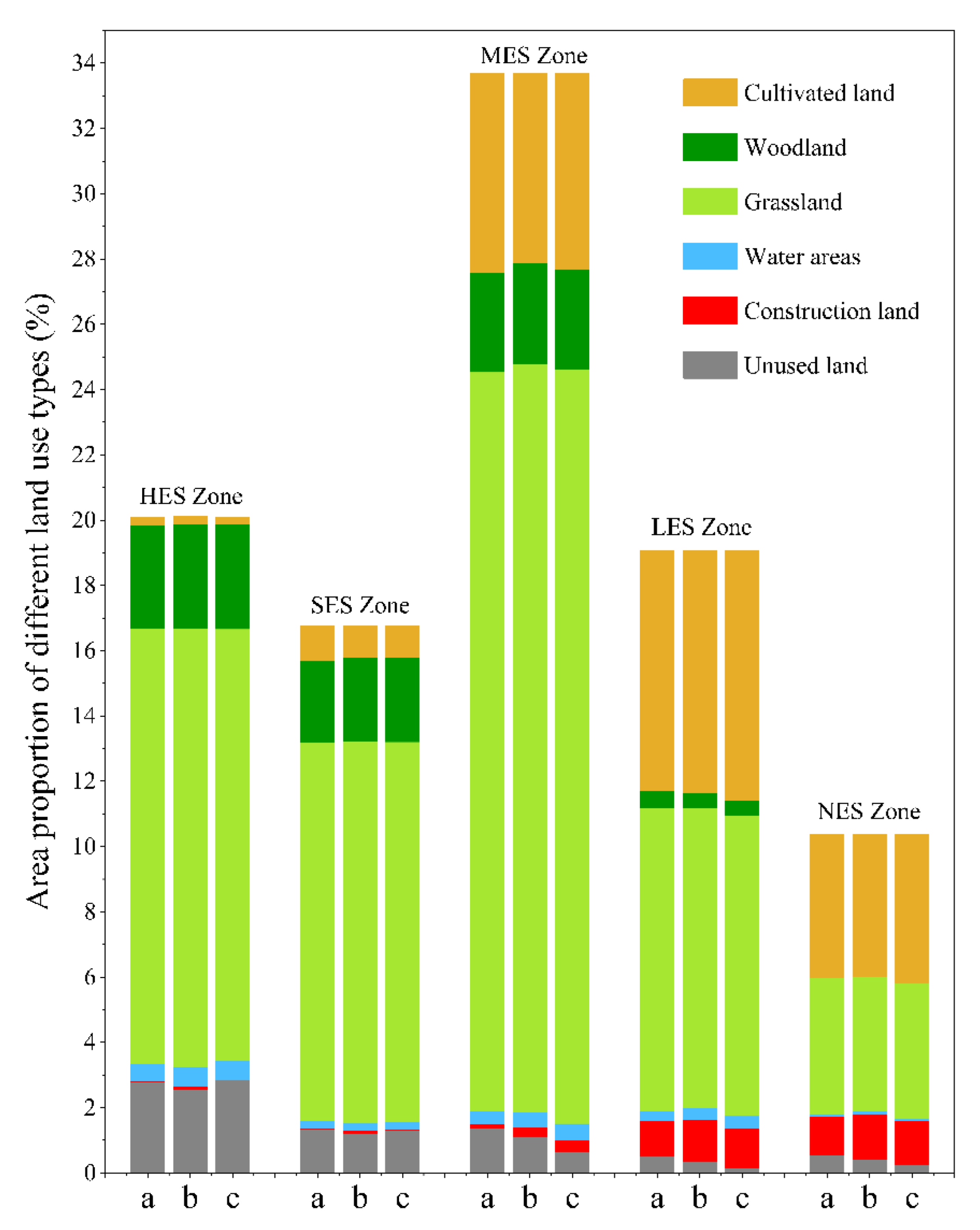
| Required Data | Data Description | Data Source |
|---|---|---|
| Land use data | Land use data during 1995 and 2020 | Data Center for Resources and Environmental Sciences, Chinese Academy of Sciences (RESDC) (http://www.resdc.cn/, accessed on 20 May 2023) |
| Geographic data | Digital elevation model (DEM) Slope data Vegetation cover (NDVI) data | Geospatial Data Cloud (http://www.gscloud.cn, accessed on 20 May 2023) Extracted from the DEM GEE (Google Earth Engine) |
| Meteorological data | Annual average precipitation for 26 years from 1995 to 2020 | Data Center for Resources and Environmental Sciences (https://www.resdc.cn, accessed on 20 May 2023) |
| Soil data | The soil type map | National Tibetan Plateau Data Center (http://data.tpdc.ac.cn, accessed on 20 May 2023) |
| Traffic data | Maps of national highways, provincial highways, county highways, and railways in 1995, 2005, 2015, and 2020 | National Tibetan Plateau Data Center |
| Statistical data | Population size, GDP, and output value of agriculture, forestry, animal husbandry, fisheries, and secondary and tertiary industries of 39 districts (counties) from 1995 to 2020 | Qinghai Statistical Yearbook and Gansu Province Development Yearbook |
| Grain output and crop sown area | The National Economic and Social Development Bulletin of each region | |
| Grain prices | National Agricultural Product Cost and Income Data Compilation |
| Abbreviations | Descriptions |
|---|---|
| LX | Lanzhou–Xining |
| LES | Land ecological suitability |
| MOP | Multi-objective linear programming |
| MCR | Minimum cumulative resistance |
| Dyna-CLUE | Dynamic Conversion of Land Use and its Effects |
| HES | High Ecological Suitability |
| SES | Sub-high Ecological Suitability |
| MES | Medium Ecological Suitability |
| LES | Low Ecological Suitability |
| NES | Non-Ecological Suitability |
| Land Use Types | Cultivated Land | Woodland | Grassland | Water Area | Construction Land | Unused |
|---|---|---|---|---|---|---|
| Eco per area (Yuan/ha) | 490,726.6 | 2666.9 | 29,548.3 | 2270.9 | 3,793,715.3 | 0 |
| ESV per area (Yuan/ha) | 5047 | 26,688.15 | 16,344.61 | 92,051.93 | 0 | 880.69 |
| Constrained Objectives | The Formulas | The Illustration |
|---|---|---|
| Total land area constraint | The total area of various types of land use should be equal to that of the study area and remains unchanged. | |
| Economic benefit constraint | According to the average annual GDP growth rate of 6.5% and 5.5% in Gansu Province and Qinghai Province of the 14th Five-Year Plan, the total GDP in 2035 was predicted based on the total GDP in 2020. Considering the impact of uncertain factors such as epidemics and natural disasters, the forecast for 2035 was reduced by 5%, which was finally utilized as the minimum value of the total land economic benefits in 2035. | |
| Grain yield constraint | 4487.779 s1 ≥ 450 * 13,698,000 | According to the food production safety standard in China, the total grain output of cultivated land in 2035 must meet the well-off standard line of the entire population in the urban agglomeration in the current year, that is, 450 kg/a per capita. The population in 2035 was predicted to be about 13.698 million by the GM (1,1) model on the basis of 1995–2020. |
| Green equivalent constraint | 0.46s1 + s2 + 0.49s3 ≥ 46,239,966.870866 | “Green equivalent” refers to the “Green amount” with the ecological function of the quantitative forest, which can provide quantitative photosynthesis. Generally, land use types that can provide green equivalent include woodland, grassland, and cropland, with coefficients of 1, 0.49, and 0.46, respectively [35,59]. The green equivalent of the LX urban agglomeration in 2035 was expected not to be lower than that of 2020. |
| Cultivated land constraint | 1,401,164.9 < s1 ≤ 1,846,355.7 * 0.02 | According to the land use planning of Gansu Province and Qinghai Province and the proportion of cultivated land in the LX area of the total cultivated land in the two provinces, the minimum quantity of cultivated land is 14,011,64.9 ha in 2020. This was determined to be the minimum of cultivated land area in 2035. According to the probability of land transfer, the maximum of cultivated land area would increase by 0.5% on the basis of 2020. |
| Woodland constraints | 893,032.7 ≤ s2 ≤ 895,172.1 | Since 2005, the area of forest land in this area has been increasing. Thus, we set the area of woodland in 2020 as the minimum and the area in 2035 predicted by the Markov chain as the maximum. |
| Grassland area constraint | 5,880,846.984 ≤ s3 ≤ 5,909,801.248 | Because the grassland of the LX region increased during 1995 and 2020, the minimum grassland area was the current situation in 2020, and the maximum was that in 2035 predicted by the Markov chain under the business as usual scenario. |
| Water area constraint | 155,829.28 ≤ s4 ≤ 171,020.5359 | The water areas are also on the rise. Thus, the water areas in 2020 were set as the lower bound, and the water areas in 2035 predicted by the Markov chain were the upper bound. |
| Construction land constraint | 233,547.0344 ≤ s5 ≤ 233,547.0344 * 1.25 | The built-up area is relatively stable and the probability of conversion to other land use type is small. Therefore, the current construction land area was set as the lower bound. Due to the limited construction land stock, the upper bound would only increase by 25% on the basis of 2020. |
| Unutilized land constraint | s6 ≥ 642,032.4015 * 0.025 | In order to maintain the diversity of land landscape, the proportion of unused land was set at no less than 2.5% of the total area of the study area according to previous studies [29]. |
| Land Use Types | 1995–2005 | 2005–2015 | 2015–2020 | 1995–2020 | ||||
|---|---|---|---|---|---|---|---|---|
| The Changed Area (ha) | Average Annual Change Rate (%) | The Changed Area (ha) | Average Annual Change Rate (%) | The Changed Area (ha) | Average Annual Change Rate (%) | The Changed Area (ha) | Average Annual Change Rate (%) | |
| Cultivated land | −23,695.71 | −0.13 | −17,714.63 | −0.09 | −11,481.70 | −0.12 | −52,892.04 | −0.11 |
| Woodland | −3928.82 | −0.04 | 2643.33 | 0.03 | −543.34 | −0.01 | −1828.82 | −0.01 |
| Grassland | 26,514.93 | 0.05 | 71,258.19 | 0.12 | −23,246.03 | −0.08 | 74,527.09 | 0.05 |
| Water areas | 10,237.45 | 0.77 | 12,658.44 | 0.88 | 5016.03 | 0.66 | 27,911.92 | 0.79 |
| Construction land | 19,488.98 | 1.42 | 45,846.69 | 2.73 | 39,095.54 | 3.73 | 104,431.21 | 2.40 |
| Unused land | −28,616.83 | −0.37 | −114,692.02 | −1.61 | −8840.50 | −0.27 | −152,149.35 | −0.85 |
| Dynamic index | 2.83 | 3.20 | 1.41 | 2.29 | ||||
| Threshold Interval | LES Zones | Area (ha) | Proportion (%) | Development Direction |
|---|---|---|---|---|
| −184,525–31,378.70 | HES | 1,594,521.04 | 16.52 | Ecological core zone |
| −31,378.70–20,233.24 | SES | 987,653.33 | 10.23 | |
| −20,233.24–4248.30 | MES | 3,705,424.71 | 38.39 | Ecological buffer zone |
| −4248.30–2790.93 | LES | 2,361,127.95 | 24.46 | Suitable construction zone |
| 2790.93–69,369 | NES | 1,002,907.37 | 10.39 | Suitable construction zone |
| Driving Factors | Exp(B) and ROC Values for Regression Results in 1995 | |||||
|---|---|---|---|---|---|---|
| Cultivated Land | Woodland | Grassland | Water Areas | Construction Land | Unused Land | |
| Elevation (m) | 0.99771 | 1.00037 | −0.00036 | 0.99828 | 1.00185 | |
| Slope (°) | 0.86700 | 1.16772 | 1.01951 | 0.90863 | 0.84614 | 1.00810 |
| Multi-year mean precipitation (mm) | 0.99991 | 1.00003 | 0.99999 | 1.00001 | 0.99968 | 0.99999 |
| Soil type | 1.00001 | 1.00000 | 0.99999 | 0.99999 | 0.99997 | 1.00000 |
| Vegetation coverage (%) | 1.00003 | 1.00002 | 1.00001 | 0.99636 | 0.99997 | 1.00001 |
| Distance to main roads (m) | 1.00020 | 0.99995 | 0.99987 | 0.900074 | 1.00013 | |
| Distance to city center (m) | 0.99097 | 1.00927 | 1.00335 | 0.98743 | 0.98000 | 0.98445 |
| Distance to water areas (m) | 52.32222 | 2931.783 | 0.24949 | 0.28634 | 25.22859 | 0.00050 |
| GDP per capita (yuan/person) | 1.00017 | 1.00015 | 1.00001 | 1.00007 | 0.99992 | |
| Population Density (person/ha) | 1.00011 | 0.99980 | 0.99952 | 1.00054 | 0.99532 | |
| ROC | 0.805202 | 0.856321 | 0.780534 | 0.982141 | 0.870614 | 0.885693 |
| Driving factors | Exp(B) and ROC values for regression results in 2005 | |||||
| Cultivated land | Woodland | Grassland | Water areas | Construction land | Unused land | |
| Elevation (m) | 0.99759 | 0.99986 | 1.00044 | 0.99829 | 1.00226 | |
| Slope (°) | 0.86547 | 1.15514 | 1.01841 | 0.91704 | 0.83336 | 0.99355 |
| Multi-year mean precipitation (mm) | 0.99990 | 1.00004 | 0.99999 | 1.00002 | 0.99964 | 0.99997 |
| Soil type | 1.00001 | 1.00000 | 0.99999 | 0.99999 | 0.99997 | 1.00000 |
| Vegetation coverage (%) | 1.00004 | 1.00002 | 1.00001 | 0.99479 | 0.99998 | 0.99999 |
| Distance to main roads (m) | 1.00027 | 0.99985 | 0.99992 | |||
| Distance to city center (m) | 0.98925 | 1.00465 | 1.00348 | 0.98066 | 0.98105 | 0.97755 |
| Distance to water areas (m) | 21.81966 | 1077.347 | 0.35112 | 0.26198 | 14.77016 | 0.00122 |
| GDP per capita (yuan/person) | 1.00003 | 1.00000 | 1.00002 | 1.00003 | 0.99999 | |
| Population Density (person/ha) | 0.99986 | 0.99967 | 1.00047 | 0.99767 | ||
| ROC | 0.80036 | 0.85206 | 0.77652 | 0.98982 | 0.87329 | 0.8695 |
| Driving factors | Exp(B) and ROC values for regression results in 2015 | |||||
| Cultivated land | Woodland | Grassland | Water areas | Construction land | Unused land | |
| Elevation (m) | 0.99804 | 1.00042 | 0.99975 | 0.99890 | 1.00200 | |
| Slope (°) | 0.86107 | 1.15786 | 1.02914 | 0.91733 | 0.80097 | 0.96678 |
| Multi-year mean precipitation (mm) | 0.99990 | 1.00003 | 0.99999 | 1.00004 | 0.99956 | 0.99998 |
| Soil type | 1.00000 | 0.99999 | 1.00000 | 1.00000 | 0.99993 | 1.00001 |
| Vegetation coverage (%) | 1.00003 | 1.00002 | 1.00002 | 0.99295 | 0.99996 | |
| Distance to main roads (m) | 1.00005 | 0.99994 | 0.99993 | 0.99979 | 0.90033 | 1.00011 |
| Distance to city center (m) | 0.98589 | 1.00405 | 0.96897 | 0.98491 | 0.98891 | |
| Distance to water areas (m) | 17.93796 | 565.7318 | 0.29255 | 1.43875 | 0.70525 | 0.00090 |
| GDP per capita (yuan/person) | 1.00001 | 1.00001 | 1.00000 | 1.00001 | 0.99999 | |
| Population Density (person/ha) | 0.99992 | 1.00011 | 0.99975 | 1.00023 | 0.99984 | |
| ROC | 0.7955 | 0.85607 | 0.79188 | 0.99368 | 0.87892 | 0.88425 |
| Driving factors | Exp(B) and ROC values for regression results in 2020 | |||||
| Cultivated land | Woodland | Grassland | Water areas | Construction land | Unused land | |
| Elevation (m) | 0.99801 | 1.00023 | 1.00030 | 0.99964 | 0.99916 | 1.00165 |
| Slope (°) | 0.85526 | 1.15430 | 1.02840 | 0.89867 | 0.76904 | 0.97528 |
| Multi-year mean precipitation (mm) | 0.99989 | 1.00003 | 1.00006 | 0.99966 | 0.99997 | |
| Soil type | 1.00000 | 1.00000 | 1.00000 | 0.99999 | 0.99993 | 1.00001 |
| Vegetation coverage (%) | 1.00003 | 1.00002 | 1.00002 | 0.92930 | 0.99999 | 1.00001 |
| Distance to main roads (m) | 1.00016 | 0.99975 | 0.90054 | 1.00010 | ||
| Distance to city center (m) | 0.98490 | 1.00291 | 1.00264 | 0.96661 | 0.99171 | 0.99621 |
| Distance to water areas (m) | 28.81471 | 3281.99 | 0.42438 | 0.02481 | 0.00071 | |
| GDP per capita (yuan/person) | 1.00003 | 1.00001 | 1.00001 | 1.00001 | 0.99999 | |
| Population Density (person/ha) | 0.99993 | 1.00010 | 0.99979 | 0.99989 | 1.00018 | 0.99908 |
| ROC | 0.79286 | 0.86102 | 0.76721 | 0.99657 | 0.87343 | 0.89383 |
| Simulation Years | 2020 Simulated in 1995 | 2015 Simulated in 1995 | 2005 Simulated in 1995 | 2020 Simulated in 2005 | 2015 Simulated in 2005 | 2020 Simulated in 2015 |
|---|---|---|---|---|---|---|
| Overall Accuracy | 0.9694 | 0.9760 | 0.9959 | 0.9727 | 0.9807 | 0.9834 |
| Kappa Coefficient | 0.9355 | 0.9442 | 0.9844 | 0.9472 | 0.9564 | 0.9891 |
| Simulation Scenarios | Ecological Benefits | Economic Benefits |
|---|---|---|
| Business as usual scenario | 172,386.2339 | 157,677,615.9 |
| Ecological optimization scenario | 187,490.4595 | 151,808,605.1 |
Disclaimer/Publisher’s Note: The statements, opinions and data contained in all publications are solely those of the individual author(s) and contributor(s) and not of MDPI and/or the editor(s). MDPI and/or the editor(s) disclaim responsibility for any injury to people or property resulting from any ideas, methods, instructions or products referred to in the content. |
© 2023 by the authors. Licensee MDPI, Basel, Switzerland. This article is an open access article distributed under the terms and conditions of the Creative Commons Attribution (CC BY) license (https://creativecommons.org/licenses/by/4.0/).
Share and Cite
Chen, X.; Zhao, R.; Shi, P.; Zhang, L.; Yue, X.; Han, Z.; Wang, J.; Dou, H. Land Use Optimization Embedding in Ecological Suitability in the Embryonic Urban Agglomeration. Land 2023, 12, 1164. https://doi.org/10.3390/land12061164
Chen X, Zhao R, Shi P, Zhang L, Yue X, Han Z, Wang J, Dou H. Land Use Optimization Embedding in Ecological Suitability in the Embryonic Urban Agglomeration. Land. 2023; 12(6):1164. https://doi.org/10.3390/land12061164
Chicago/Turabian StyleChen, Xidong, Ruifeng Zhao, Peiji Shi, Lihua Zhang, Xiaoxin Yue, Ziyi Han, Jingfa Wang, and Hanmei Dou. 2023. "Land Use Optimization Embedding in Ecological Suitability in the Embryonic Urban Agglomeration" Land 12, no. 6: 1164. https://doi.org/10.3390/land12061164
APA StyleChen, X., Zhao, R., Shi, P., Zhang, L., Yue, X., Han, Z., Wang, J., & Dou, H. (2023). Land Use Optimization Embedding in Ecological Suitability in the Embryonic Urban Agglomeration. Land, 12(6), 1164. https://doi.org/10.3390/land12061164





